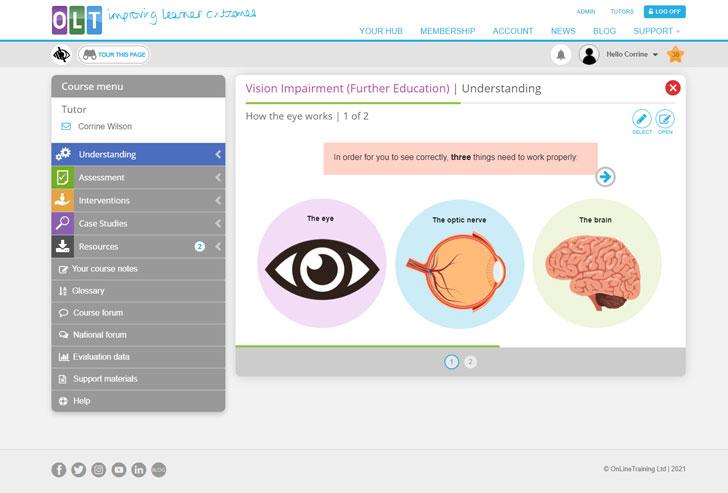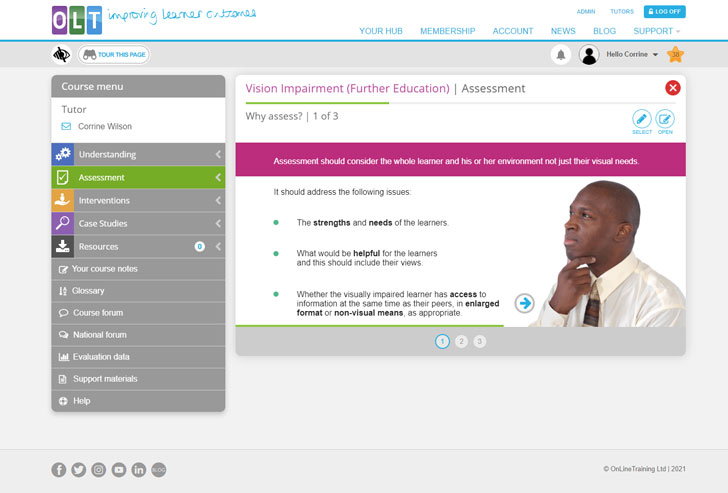
The term vision impairment is used to describe a loss of sight where the person ranges from severely sight impaired (blind) to sight impaired (partially sighted). Around 4,600 students aged 16 to 18 (RNIB, 2021) in colleges of further education have a vision impairment. A young person is thought to have a vision impairment if they have an eye condition that cannot be fully corrected using glasses or contact lenses.
Vision impairment is a lifelong disability that requires proactive specialist provision and support if the learner is to develop fundamental skills, make equivalent learning achievements and lead emotionally resilient and independent lives. Where a learner does not have access to the same visual experiences and cues as their peers, their learning opportunities can be significantly impaired.
This course responds to the information needs of the whole community centred around supporting the young person with a hearing impairment. You will learn how to assess the needs of a learner and go on to develop a support plan consisting of SMART goals and interventions, which you will implement and later review to determine how well it has met the learner’s developmental needs.
Our Vision Impairment course is perfect for those who work with students in a further education setting such as teachers, college tutors, teaching assistants, heads of department and college leaders. This course is also useful for the parents/carers of students with a vision impairment.
Our courses are structured into four sections. Click on the section headings to reveal page titles and some example content.
Understand what visual impairment is and the importance of inclusion in a further education setting.
- Section objectives
- What is vision impairment?
-
How the eye works

Screenshot from Understanding page 3 - Common eye conditions
- Albinism
- Aniridia
- Astigmatism
- Cataracts
- Optic atrophy
- Glaucoma
- Hypermetropia (long sight)
- Maculopathy
-
Myopia (short sighted)

Screenshot from Understanding page 13 - Nystagmus
- Retinitis pigmentosa
- Facts and figures
- Quick quiz: Fact or fiction – common eye myths
- A history of the education of those with visual impairment
- The history of visual impairment – 20th century
- How does vision impairment affect a child’s development?
- End of section quiz
- Section summary
Explore some of the formal and informal tests used to assess vision and its implications for learning.
- Section objectives and your learner profile
-
Why assess?

Screenshot from Assessment page 2 - Visual assessment
- What does visual acuity mean?
- Functional vision and its effects on learning
- Can’t read print/see pictures
-
Strategies to improve access

Screenshot from Assessment page 7 - Assessing individual needs
- Social interaction and communication
- Learning needs
- Mobility needs
- Assessing the environment
- Planning for independence
- Course assignment: Your learner’s three SMART goals
- Section summary
Choose from a range of strategies to develop personalised learning programmes to ensure equality of access for learners with vision impairment.
- Section objectives
- Considerations to ensure curriculum delivery
- Advance planning
- Modification of materials and provision of additional resources
- Adapting the classroom environment
-
Use of technology and other resources

Screenshot from Interventions page 6 - Self-help and independence skills
- Social skills
- Specific interventions
-
Educational provision

Screenshot from Interventions page 10 - Course assignment: Your learner’s interventions
- End of section quiz
- Section summary
View real life examples of interventions and their resulting progress.
- Case study: Nancy prepares for A levels
- Case study: Introduction: Sussex Downs College
- Case study: Sussex Downs College – Rohan
- Case study: Lewes college – David
- Case study: Sussex Downs College supporting mature students
- Case study: Transitions to college, university or work
Other Position
Teaching Assistant
Teaching Assistant
Teaching Assistant
Teaching Assistant
Teaching Assistant
Teaching Assistant
Other Position
Qualified Teacher
Advisory Teacher
Course learning outcomes
On successful completion of the course, you will be able to:
- describe the impact that vision loss can have on student learning and social inclusion
- use checklists to carry out observations of a student’s functional vision
- make appropriate adjustments in the classroom environment to support the learning and social inclusion of vision impaired students
- employ strategies to increase independent learning skills
- prepare students for transition to work or university
- create a support plan for a pupil/group of pupils in your school

